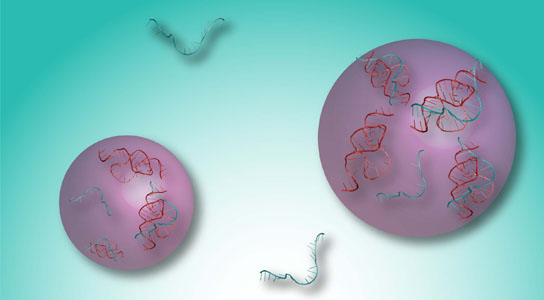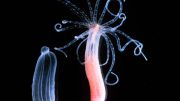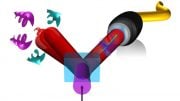
Shown are RNA strands (blue) and RNA enzymes (red) coming together within droplets of dextran. Scientists at Penn State have shown that this compartmentalization helps to catalyze chemical reactions. Credit: C. A. Strulson
Using polymers, scientists at Penn State created primitive cell-like structures that they infused with RNA, demonstrating how the molecules would react chemically under conditions that may have been present on Earth four billion years ago.
Researchers at Penn State University have developed a chemical model that mimics a possible step in the formation of cellular life on Earth four billion years ago. Using large “macromolecules” called polymers, the scientists created primitive cell-like structures that they infused with RNA — the genetic coding material that is thought to precede the appearance of DNA on Earth — and demonstrated how the molecules would react chemically under conditions that might have been present on the early Earth. The journal Nature Chemistry will post the research as an Advance Online Publication on 14 October 2012.
In modern biology, all life, with the exception of some viruses, uses DNA as its genetic storage mechanism. According to the “RNA-world” hypothesis, RNA appeared on Earth first, serving as both the genetic-storage material and the functional molecules for catalyzing chemical reactions, then DNA and proteins evolved much later. Unlike DNA, RNA can adopt many different molecular conformations and so it is functionally interactive on the molecular level. In the soon-to-be-published research paper, two professors of chemistry, Christine Keating and Philip Bevilacqua, and two graduate students, Christopher Strulson and Rosalynn Molden, probe one of the nagging mysteries of the RNA-world hypothesis.
“A missing piece of the RNA-world puzzle is compartmentalization,” Bevilacqua said. “It’s not enough to have the necessary molecules that make up RNA floating around; they need to be compartmentalized and they need to stay together without diffusing away. This packaging needs to happen in a small-enough space — something analogous to a modern cell — because a simple fact of chemistry is that molecules need to find each other for a chemical reaction to occur.”
To test how early cell-like structures could have formed and acted to compartmentalize RNA molecules even in the absence of lipid-like molecules that make up modern cellular membranes, Strulson and Molden generated simple, non-living model “cells” in the laboratory. “Our team prepared compartments using solutions of two polymers called polyethylene glycol (PEG) and dextran,” Keating explained. “These solutions form distinct polymer-rich aqueous compartments, into which molecules like RNA can become locally concentrated.”
The team members found that, once the RNA was packed into the dextran-rich compartments, the molecules were able to associate physically, resulting in chemical reactions. “Interestingly, the more densely the RNA was packed, the more quickly the reactions occurred,” Bevilacqua explained. “We noted an increase in the rate of chemical reactions of up to about 70-fold. Most importantly, we showed that for RNA to ‘do something’ — to react chemically — it has to be compartmentalized tightly into something like a cell. Our experiments with aqueous two-phase systems (ATPS) have shown that some compartmentalization mechanism may have provided catalysis in an early-Earth environment.”
Keating added that, although the team members do not suggest that PEG and dextran were the specific polymers present on the early Earth, they provide a clue to a plausible route to compartmentalization — phase separation. “Phase separation occurs when different types of polymers are present in solution at relatively high concentrations. Instead of mixing, the sample separates to form two distinct liquids, similar to how oil and water separate.” Keating explained. “The aqueous-phase compartments we manufactured using dextran and PEG can drive biochemical reactions by increasing local reactant concentrations. So, it’s possible that some other sorts of polymers might have been the molecules that drove compartmentalization on the early Earth.” Strulson added that, “In addition to the RNA-world hypothesis, these results may be relevant to RNA localization and function in non-membrane compartments in modern biology.”
The team members also found that the longer the string of RNA, the more densely it would be packed into the dextran compartment of the ATPS, while the shorter strings tended to be left out. “We hypothesize that this research result might indicate some kind of primitive sorting method,” Bevilacqua said. “As RNA gets shorter, it tends to have less enzyme activity. So, in an early-Earth system similar to our dextran-PEG model system, the full-length, functional RNA would have been sorted and concentrated into one phase, while the shorter RNA that is not only less functional, but also threatens to inhibit important chemical reactions, would not have been included.”
The scientists hope to continue their investigations by testing their model-cell method with other polymers. Keating added, “We are interested in looking at compartmentalization in polymer systems that are more closely related to those that may have been present on the early Earth, and also those that may be present in contemporary biological cells, where RNA compartmentalization remains important for a wide range of cellular processes.”
Reference: “RNA catalysis through compartmentalization” by Christopher A. Strulson, Rosalynn C. Molden, Christine D. Keating and Philip C. Bevilacqua, 14 October 2012, Nature Chemistry.
DOI: 10.1038/nchem.1466
This research was funded by the National Science Foundation (grant CHE-0750196).








Ribo Nucleic Acid molecule, when it loses an Oxygen Atom,it becomes, De-Oxy Ribo Nucleic Acid Molecule. Thus RNA is senior to DNA in the living world. According to the article RNA is highly active and its activity is 70 folded when compartmentalized and density becomes more on packing. It is true. A virus is also compartmentalized with RNA or DNA. A cell nucleus is also compartmentalized in the cell nucleus. You can extend this theory to phospho-lipid bilayer of cells, or encapsuled mitochondria, or ribosome or golgi complex and even chromosomes where everything is encased probably to increase the catalyzing and enzyme capacity. RNA is doing a myriad of things in biological world. It is the interfering RNA (i-RNA) that is responsible for respective tissue unction to select the appropriate messenger RNA (m-RNA) sent from DNA complex. It is this wonderful property of RNA that brought Nobel Prize a couple of years earlier to the scientists. Moreover RNA route is employed in many pharmaceutical firms to send the specific drug molecule to counter the bacteria. Thank You.